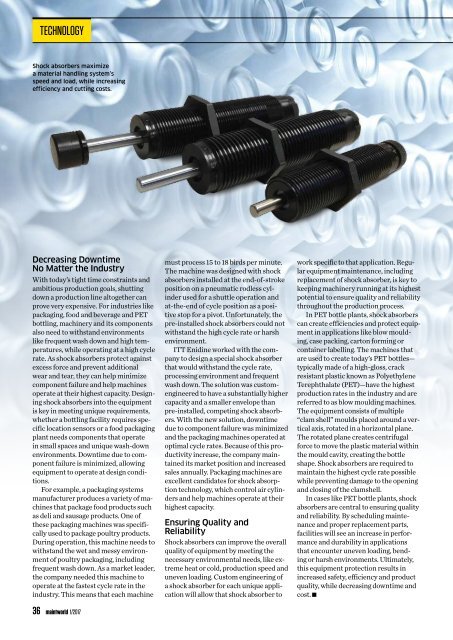Maintworld 1/2017
Create successful ePaper yourself
Turn your PDF publications into a flip-book with our unique Google optimized e-Paper software.
TECHNOLOGY<br />
Shock absorbers maximize<br />
a material handling system’s<br />
speed and load, while increasing<br />
efficiency and cutting costs.<br />
Decreasing Downtime<br />
No Matter the Industry<br />
With today’s tight time constraints and<br />
ambitious production goals, shutting<br />
down a production line altogether can<br />
prove very expensive. For industries like<br />
packaging, food and beverage and PET<br />
bottling, machinery and its components<br />
also need to withstand environments<br />
like frequent wash down and high temperatures,<br />
while operating at a high cycle<br />
rate. As shock absorbers protect against<br />
excess force and prevent additional<br />
wear and tear, they can help minimize<br />
component failure and help machines<br />
operate at their highest capacity. Designing<br />
shock absorbers into the equipment<br />
is key in meeting unique requirements,<br />
whether a bottling facility requires specific<br />
location sensors or a food packaging<br />
plant needs components that operate<br />
in small spaces and unique wash-down<br />
environments. Downtime due to component<br />
failure is minimized, allowing<br />
equipment to operate at design conditions.<br />
For example, a packaging systems<br />
manufacturer produces a variety of machines<br />
that package food products such<br />
as deli and sausage products. One of<br />
these packaging machines was specifically<br />
used to package poultry products.<br />
During operation, this machine needs to<br />
withstand the wet and messy environment<br />
of poultry packaging, including<br />
frequent wash down. As a market leader,<br />
the company needed this machine to<br />
operate at the fastest cycle rate in the<br />
industry. This means that each machine<br />
36 maintworld 1/<strong>2017</strong><br />
must process 15 to 18 birds per minute.<br />
The machine was designed with shock<br />
absorbers installed at the end-of-stroke<br />
position on a pneumatic rodless cylinder<br />
used for a shuttle operation and<br />
at-the-end of cycle position as a positive<br />
stop for a pivot. Unfortunately, the<br />
pre-installed shock absorbers could not<br />
withstand the high cycle rate or harsh<br />
environment.<br />
ITT Enidine worked with the company<br />
to design a special shock absorber<br />
that would withstand the cycle rate,<br />
processing environment and frequent<br />
wash down. The solution was customengineered<br />
to have a substantially higher<br />
capacity and a smaller envelope than<br />
pre-installed, competing shock absorbers.<br />
With the new solution, downtime<br />
due to component failure was minimized<br />
and the packaging machines operated at<br />
optimal cycle rates. Because of this productivity<br />
increase, the company maintained<br />
its market position and increased<br />
sales annually. Packaging machines are<br />
excellent candidates for shock absorption<br />
technology, which control air cylinders<br />
and help machines operate at their<br />
highest capacity.<br />
Ensuring Quality and<br />
Reliability<br />
Shock absorbers can improve the overall<br />
quality of equipment by meeting the<br />
necessary environmental needs, like extreme<br />
heat or cold, production speed and<br />
uneven loading. Custom engineering of<br />
a shock absorber for each unique application<br />
will allow that shock absorber to<br />
work specific to that application. Regular<br />
equipment maintenance, including<br />
replacement of shock absorber, is key to<br />
keeping machinery running at its highest<br />
potential to ensure quality and reliability<br />
throughout the production process.<br />
In PET bottle plants, shock absorbers<br />
can create efficiencies and protect equipment<br />
in applications like blow moulding,<br />
case packing, carton forming or<br />
container labelling. The machines that<br />
are used to create today’s PET bottles—<br />
typically made of a high-gloss, crack<br />
resistant plastic known as Polyethylene<br />
Terephthalate (PET)—have the highest<br />
production rates in the industry and are<br />
referred to as blow moulding machines.<br />
The equipment consists of multiple<br />
“clam shell” moulds placed around a vertical<br />
axis, rotated in a horizontal plane.<br />
The rotated plane creates centrifugal<br />
force to move the plastic material within<br />
the mould cavity, creating the bottle<br />
shape. Shock absorbers are required to<br />
maintain the highest cycle rate possible<br />
while preventing damage to the opening<br />
and closing of the clamshell.<br />
In cases like PET bottle plants, shock<br />
absorbers are central to ensuring quality<br />
and reliability. By scheduling maintenance<br />
and proper replacement parts,<br />
facilities will see an increase in performance<br />
and durability in applications<br />
that encounter uneven loading, bending<br />
or harsh environments. Ultimately,<br />
this equipment protection results in<br />
increased safety, efficiency and product<br />
quality, while decreasing downtime and<br />
cost.

















